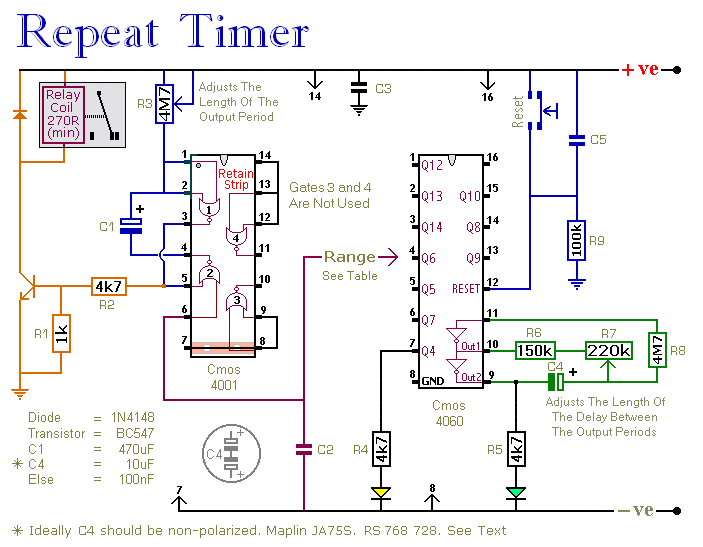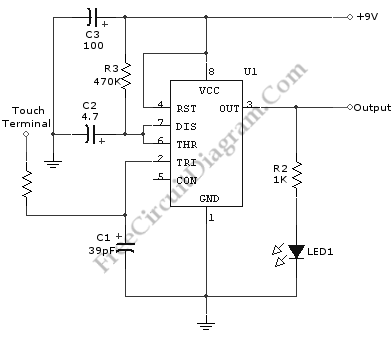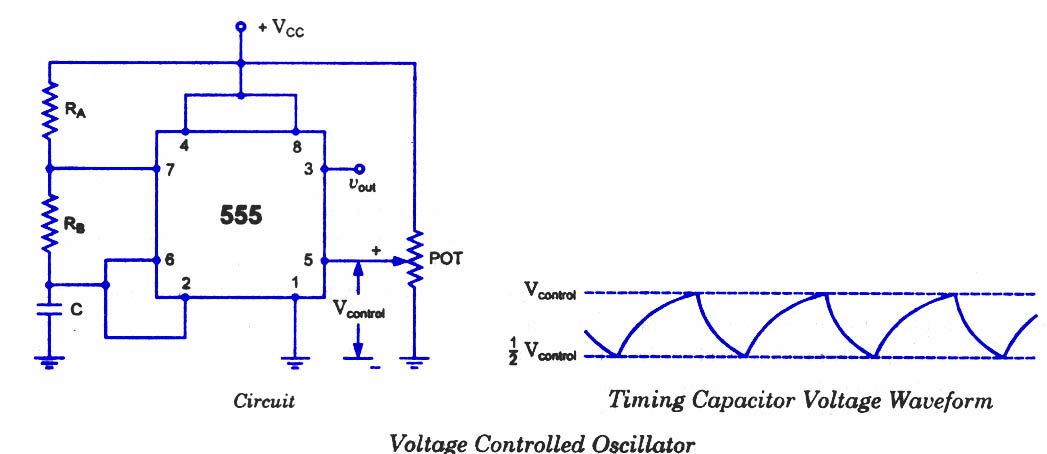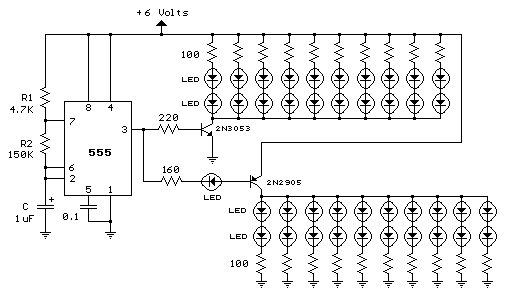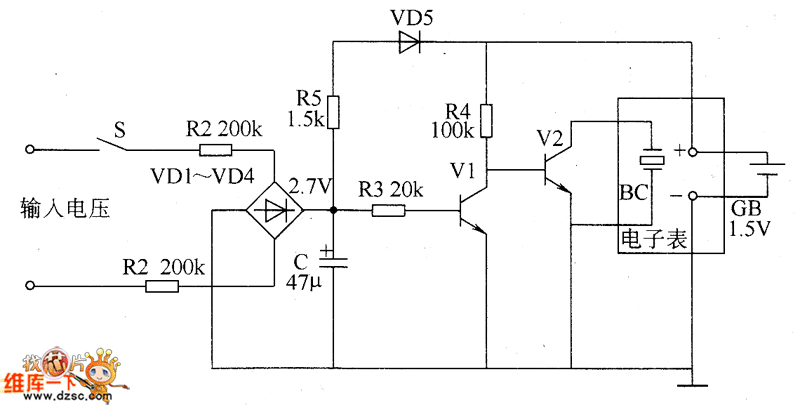
Long-Duration Time Delay
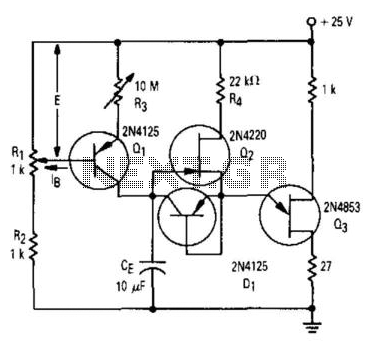
Transistor Q1 and resistors R1, R2, and R3 form a constant current source, with the charge current adjustable to as low as a few nanoamperes. This current is insufficient to activate the UJT, where IP is 0.2 A, unless a peak current is supplied from an external source. Field-effect transistor Q2 operates as a source follower, delivering current to the emitter lead before firing, while diode D1 provides a low-impedance discharge path for capacitor Ce. D1 must be chosen to have a leakage current significantly lower than the charge current. Due to the small base current IB, the delay time varies linearly with resistor R3. The voltage (E) across R3 and the base-emitter junction of Q1 is determined by the variable resistor R1. Time delays of up to 10 hours can be achieved with this circuit. Resistor R4, connected in series with the FET drain terminal, must be sufficiently large to prevent currents exceeding Iy when the UJT is active; otherwise, the UJT will not turn off, causing the circuit to latch up.
The circuit described utilizes a combination of a bipolar junction transistor (BJT) and a field-effect transistor (FET) to create a highly adjustable timing mechanism. The primary component, transistor Q1, works in conjunction with resistors R1, R2, and R3 to establish a constant current source. This current source is capable of being fine-tuned to deliver a minimal charge current, which is particularly beneficial for applications requiring low power consumption.
The adjustment capability allows the circuit to operate at very low current levels, which is crucial for applications where energy efficiency is paramount. However, the current level must remain below the threshold necessary to trigger the UJT, which requires a peak current of 0.2 A. To circumvent this limitation, an external source can be employed to provide the necessary peak current when required.
Field-effect transistor Q2 serves a critical role as a source follower, ensuring that the current flows smoothly into the emitter lead of the UJT prior to its activation. This configuration aids in maintaining the integrity of the timing sequence by controlling the discharge of capacitor Ce through diode D1. The selection of diode D1 is essential; it must exhibit a leakage current that is significantly lower than the charge current to ensure that the timing mechanism operates effectively without premature triggering.
The circuit's design also incorporates a variable resistor R1, which dictates the voltage across R3 and the base-emitter junction of Q1. This voltage setting is vital for establishing the timing characteristics of the circuit. The delay time, which can extend up to 10 hours, is directly influenced by the resistance value of R3. As IB remains small, the relationship between delay time and R3 is linear, providing predictable and controllable timing intervals.
Finally, resistor R4 is integrated into the circuit as a safeguard. It is placed in series with the drain terminal of the FET and is required to have a sufficiently high resistance to limit the current flow when the UJT is activated. This precaution prevents the UJT from remaining in an 'on' state, which could lead to circuit latching and malfunction. Overall, this circuit design effectively combines various components to create a reliable and adjustable timing mechanism suitable for low-power applications. Transistor Ql and resistors Rl, R2, and R3 form a constant current source and the charge current might be adjusted to be as low as a few nanoamperes. This current would, of course, not be sufficient to fire the UJT where IP=0.2 A, unless the peak current was supplied from another source. Field-effect transistor Q2, acting as a source follower, supplies the current flowing into the emitter lead prior to firing and diode Dl provides a low-impedance discharge path for Ce- Dl must be selected to have a leakage that is much lower than the charge current.
Because IB is small, the delay time will vary linearly with R3. The voltage (E), applied across R3 and the base-emitter junction of Ql, is set by the variable resistor Rl. Time delays up to 10 hours are possible with this circuit. Resistor R4, in series with the FET drain terminal, must be large enough not to allow currents in excess of Iy to flow when the UJT is on.
Otherwise, the UJT will not turn off and the circuit will latch up.
The circuit described utilizes a combination of a bipolar junction transistor (BJT) and a field-effect transistor (FET) to create a highly adjustable timing mechanism. The primary component, transistor Q1, works in conjunction with resistors R1, R2, and R3 to establish a constant current source. This current source is capable of being fine-tuned to deliver a minimal charge current, which is particularly beneficial for applications requiring low power consumption.
The adjustment capability allows the circuit to operate at very low current levels, which is crucial for applications where energy efficiency is paramount. However, the current level must remain below the threshold necessary to trigger the UJT, which requires a peak current of 0.2 A. To circumvent this limitation, an external source can be employed to provide the necessary peak current when required.
Field-effect transistor Q2 serves a critical role as a source follower, ensuring that the current flows smoothly into the emitter lead of the UJT prior to its activation. This configuration aids in maintaining the integrity of the timing sequence by controlling the discharge of capacitor Ce through diode D1. The selection of diode D1 is essential; it must exhibit a leakage current that is significantly lower than the charge current to ensure that the timing mechanism operates effectively without premature triggering.
The circuit's design also incorporates a variable resistor R1, which dictates the voltage across R3 and the base-emitter junction of Q1. This voltage setting is vital for establishing the timing characteristics of the circuit. The delay time, which can extend up to 10 hours, is directly influenced by the resistance value of R3. As IB remains small, the relationship between delay time and R3 is linear, providing predictable and controllable timing intervals.
Finally, resistor R4 is integrated into the circuit as a safeguard. It is placed in series with the drain terminal of the FET and is required to have a sufficiently high resistance to limit the current flow when the UJT is activated. This precaution prevents the UJT from remaining in an 'on' state, which could lead to circuit latching and malfunction. Overall, this circuit design effectively combines various components to create a reliable and adjustable timing mechanism suitable for low-power applications. Transistor Ql and resistors Rl, R2, and R3 form a constant current source and the charge current might be adjusted to be as low as a few nanoamperes. This current would, of course, not be sufficient to fire the UJT where IP=0.2 A, unless the peak current was supplied from another source. Field-effect transistor Q2, acting as a source follower, supplies the current flowing into the emitter lead prior to firing and diode Dl provides a low-impedance discharge path for Ce- Dl must be selected to have a leakage that is much lower than the charge current.
Because IB is small, the delay time will vary linearly with R3. The voltage (E), applied across R3 and the base-emitter junction of Ql, is set by the variable resistor Rl. Time delays up to 10 hours are possible with this circuit. Resistor R4, in series with the FET drain terminal, must be large enough not to allow currents in excess of Iy to flow when the UJT is on.
Otherwise, the UJT will not turn off and the circuit will latch up.
